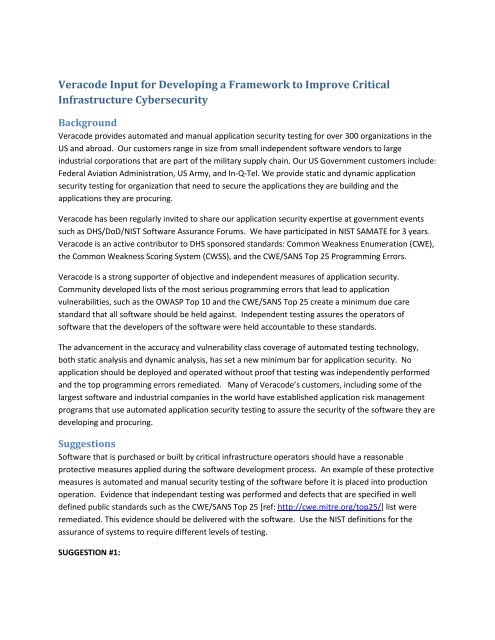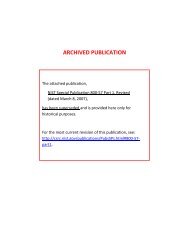RFI Comments - Veracode
RFI Comments - Veracode
RFI Comments - Veracode
Create successful ePaper yourself
Turn your PDF publications into a flip-book with our unique Google optimized e-Paper software.
<strong>Veracode</strong> Input for Developing a Framework to Improve Critical<br />
Infrastructure Cybersecurity<br />
Background<br />
<strong>Veracode</strong> provides automated and manual application security testing for over 300 organizations in the<br />
US and abroad. Our customers range in size from small independent software vendors to large<br />
industrial corporations that are part of the military supply chain. Our US Government customers include:<br />
Federal Aviation Administration, US Army, and In-Q-Tel. We provide static and dynamic application<br />
security testing for organization that need to secure the applications they are building and the<br />
applications they are procuring.<br />
<strong>Veracode</strong> has been regularly invited to share our application security expertise at government events<br />
such as DHS/DoD/NIST Software Assurance Forums. We have participated in NIST SAMATE for 3 years.<br />
<strong>Veracode</strong> is an active contributor to DHS sponsored standards: Common Weakness Enumeration (CWE),<br />
the Common Weakness Scoring System (CWSS), and the CWE/SANS Top 25 Programming Errors.<br />
<strong>Veracode</strong> is a strong supporter of objective and independent measures of application security.<br />
Community developed lists of the most serious programming errors that lead to application<br />
vulnerabilities, such as the OWASP Top 10 and the CWE/SANS Top 25 create a minimum due care<br />
standard that all software should be held against. Independent testing assures the operators of<br />
software that the developers of the software were held accountable to these standards.<br />
The advancement in the accuracy and vulnerability class coverage of automated testing technology,<br />
both static analysis and dynamic analysis, has set a new minimum bar for application security. No<br />
application should be deployed and operated without proof that testing was independently performed<br />
and the top programming errors remediated. Many of <strong>Veracode</strong>’s customers, including some of the<br />
largest software and industrial companies in the world have established application risk management<br />
programs that use automated application security testing to assure the security of the software they are<br />
developing and procuring.<br />
Suggestions<br />
Software that is purchased or built by critical infrastructure operators should have a reasonable<br />
protective measures applied during the software development process. An example of these protective<br />
measures is automated and manual security testing of the software before it is placed into production<br />
operation. Evidence that independant testing was performed and defects that are specified in well<br />
defined public standards such as the CWE/SANS Top 25 [ref: http://cwe.mitre.org/top25/] list were<br />
remediated. This evidence should be delivered with the software. Use the NIST definitions for the<br />
assurance of systems to require different levels of testing.<br />
SUGGESTION #1:
Have well defined requirements of independent application security testing against the weaknesses<br />
defined by the current CWE/SANS Top 25. Use a reference to the CWE/SANS Top 25 as it is updated<br />
annually to maintain currency with relevant risks. Automated testing is available at reasonable cost so<br />
it should be a requirement for applications that are components of MEDIUM assurance systems in<br />
addition to applications that are components of HIGH assurance systems. Applications that are<br />
components of HIGH assurance systems should require further manual testing. Independence of test<br />
execution, including static analysis, is critical because if members of the development team create the<br />
test results they are free to dismiss real issues as false positives or not applicable. This leads to<br />
vulnerabilities in the software being ignored.<br />
There is a need for the scope of controls no not just be focused on the implementation of security<br />
controls themselves but for the implementation of all software. It is clear that flaws in business<br />
software are being used to bypass security controls so even if the security controls are implemented<br />
flawlessly the flaws in the business software can be used by attackers. This is the trend we are seeing<br />
with SQL Injection attacks in web applications being used in the Night Dragon attacks on energy<br />
companies [ref: http://www.mcafee.com/us/resources/white-papers/wp-global-energy-cyberattacksnight-dragon.pdf]<br />
to bypass perimeter controls and flaws in desktop media viewing software being used<br />
for the same purpose in the RSA attacks [ref: http://blogs.rsa.com/anatomy-of-an-attack/]. All<br />
software, no matter its source (internally developed or purchased), needs to be subjected to a<br />
trustworthiness control based on its assurance level.<br />
SUGGESTION #2:<br />
Controls should encompass all applications, not just those that are components of security controls.<br />
In addition it should encompass applications that are components of MEDIUM assurance systems with<br />
automated application security testing, in addition to applications that are components of HIGH<br />
assurance systems. Applications that are components of HIGH assurance systems should require<br />
further manual testing.<br />
Contact Information<br />
If there are any questions or need for clarification please contact:<br />
Chris Wysopal<br />
cwysopal@veracode.com<br />
339-674-2703
















